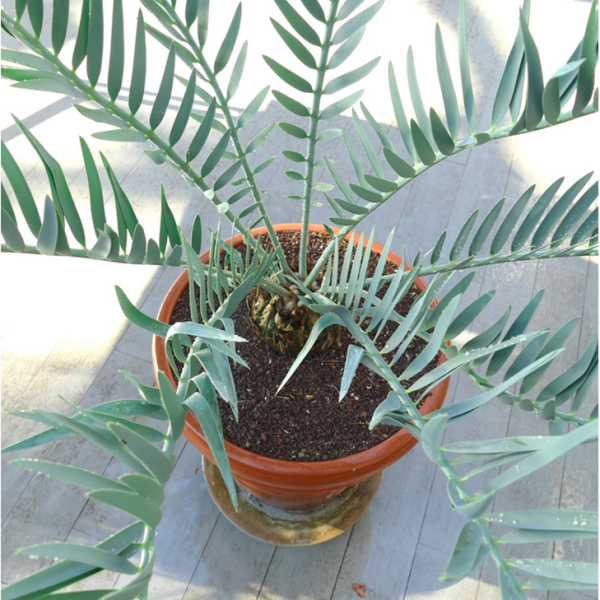E. trispinosus is famous for its powdery blue to bluish-silver leaves and fiercely armed leaflets, making it one of the most sought-after cycads in cultivation (Encphalartos Trispinosus)
- Leaves:
- Typically 50 cm to 1.2 meters long
- Powdery blue-gray to silvery-blue, especially when grown in full sun
- Leaflets are short, thick, and heavily spined — often with three prominent spines (hence the name “trispinosus“)
- Leaflets are widely spaced, giving it an open, sculptural look
- Trunk:
- Can be underground or emerge up to 1–1.5 meters
- Usually solitary but can sometimes produce pups at the base
Cones:
- Dioecious: Separate male and female plants
- Male cones: Long and narrow, bluish with a frosted appearance
- Female cones: Shorter, rounder, and often even more blue-powdered
- Very attractive and typically emerge low to the ground (Encphalartos Trispinosus)
Habitat & Ecology:
- Native to dry, rocky hillsides and scrublands in the Eastern Cape
- Adapted to full sun, low water, and poor, stony soils
- Well camouflaged in the wild — the blue leaves help reflect sun and blend into the dry landscape
Cultivation & Care
- Light: Full sun brings out the most intense blue tones
- Soil: Very well-draining, gritty or sandy is best
- Water: Low; prefers dry conditions once established
- Cold Tolerance: Handles mild frost; needs protection in hard freezes
- Growth Rate: Slow, like most cycads, but worth the wait
- Landscape Use: Perfect for rock gardens, xeriscapes, or blue-themed plant designs (Encphalartos Trispinosus)
️ Conservation:
- Protected under CITES Appendix I
- Wild populations are vulnerable due to habitat destruction and poaching
- Ethically grown, nursery-propagated specimens are widely available and help protect wild plants
Why It’s a Favorite:
- That intense powdery blue color — like a succulent and a cycad had a love child
- Its compact size makes it easier to display in smaller gardens or containers
- The heavily armored leaflets give it a prehistoric, almost alien vibe
Want to see how it stacks up next to E. horridus or E. cupidus? Or maybe you’re curious about how to bring out those deep blue hues? I got you.

Reviews
There are no reviews yet.